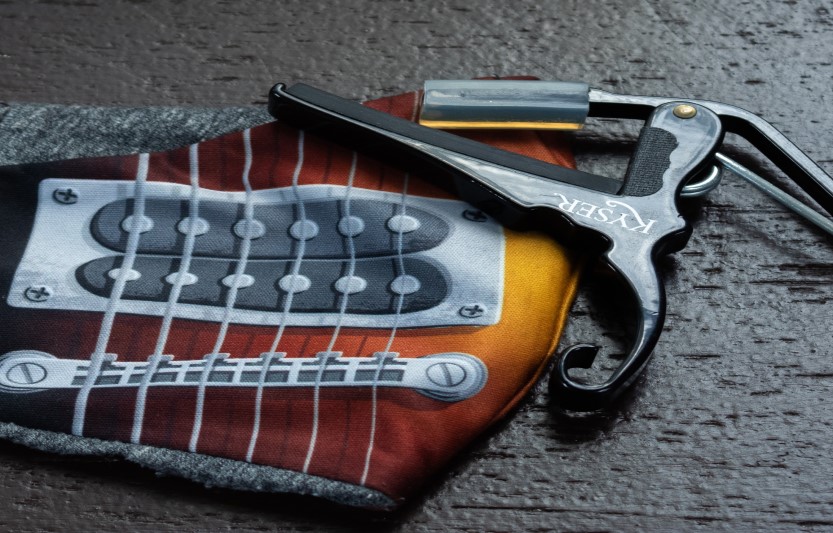
One can utter the word in a few different ways. “Capo” is short for “capodastro” or “capotasto,” and it is a derivative of the Italian term ‘head of the neck’.
A capo is essentially a small device that clamps onto the neck of a guitar to shorten the length of the strings.
A guitar is not the only string instrument this device can be used on. Capos can also be useful on any other fretted instruments such as mandolins, mandolas, banjos, ukuleles, and bouzoukis.
Capos have been around for centuries and their earliest recorded use was in 1640 by Italian musicologist and humanist Giovanni Batista Doni. The device was later patented for the first time in 1850 by James Ashborn from Wolcottville, Connecticut.
How a capo works
To fully understand how a capo works, it is also important to understand the function of a nut on a guitar. The nut is located where the fretboard meets the headstock. It is a thin strip, usually made of plastic, which contains grooves for each string to be properly placed and guided down the neck. The strings are then secured around the tuning keys.
A capo could be considered as a movable nut in the sense that it provides termination of vibration. Unlike the nut, the capo does not have string grooves and instead, presses the strings down onto the fretboard to terminate the vibration.
How to apply a Capo
Capos come in different shapes and sizes to fit all the different types of stringed instruments and fretboard curvatures. Most have a rubber-covered bar that is used to hold down the strings. The bar can be fastened to the neck with an elastic or nylon strap, a spring, a screw, or a cam-operated clamp.
The most popular type is a ‘trigger capo’ which uses a spring system. You simply open up the capo with the trigger, place it on your guitar and then release your grip. The pressure from the spring will then keep the capo securely in place.
There are quite a few other types but they are fairly simple to operate such as a screw capo that just needs screwing into place; and a Shubb capo that has a lever system you can flick into place. These capos are probably best for precision but aren’t as easy to use as a trigger capo.
The cheapest capos have a strap that wraps around the neck of the guitar and is secured into place with a notch. These capos aren’t great as they can easily slip, put sideward pressure on strings and break easily. They can also be fiddly, and it can be hard to get the right tension.
Since You’re Here…

Fast-track your guitar learning journey, with the Ukulele and Guitar Coach App by Roadie Music. (iOS | Android)
This is the first and only AI-based guitar and ukulele learning app that listens to you play and guides you with customized feedback, just like a music teacher would. Coach will mainly help you :
- Discover & master ANY chord
- Practice strumming patterns
- Learn any song from scratch & at your OWN pace
- Get personalized feedback on skills that need improvement
The capo can be applied at any point on the fretboard of an instrument. Simply open it up and move it to the desired fret. The capo should be placed in the fret just behind the fret bar. It should not be placed on top of the fret or too far back into the fret.
You want to ensure a smooth and even fit for a uniform position and pressure. This should be done to avoid any bending of the strings. Otherwise, the instrument could sound sharp or out of key. An improper application could also potentially mark the neck of a guitar. It is important to note that it is best applied after a fresh tuning.
It will be very clear when a capo has not been applied correctly as some of the strings will either be completely dulled or twang when picked. It’s always important to take care when applying the capo and either picking or strumming the strings once applied to ensure they ring out.
A very common mistake is releasing the capo’s handle without enough care. By doing this, the capo can drag or pull on the strings. An improper amount of tension could bend the strings. While this may not be visible to the untrained eye; just a little bending is all it takes for a guitar to sound out of tune.
After the capo is securely clamped, it raises the pitch of a string. You can use this higher pitch to play in a different key while still using the same fingerings. If you want to know how a capo changes the note of a string, charts can easily be found on a Google image search.
Why use a capo?
There are many reasons to use a capo. However, the main advantage is the ability to play songs in different keys without adjusting the tuning keys. This way, a guitarist can change the pitch of open notes or open-string chord forms, and the fretted notes will not change.
A common misunderstanding is that a capo is often used for “cheating” when playing the guitar. It is true that the device is used to change keys with ease, but that does not validate the negative perception of using capos.
They can be used for beginners who may have a tough time fingering certain chords as it requires less stretching of the left hand. For most people, it simply makes their life easier and can open up a whole new world beyond regular open chords.
Capos have also proven to be incredibly useful for singers in the sense that you can shift the key up to a scale that suits the vocalist. This allows for a guitarist to adjust the song rather than the singer adjusting their voice in a way that may be too difficult.
They will also not be forced to re-learn the song with different chord shapes. Another reason would be to harmonize between two guitarists. With a capo, you can explore the differences in timbre, which is the tone or quality of the sound. This can create a beautiful variety of expressions in songs.
The genres
There are particular genres of music where capos are more commonly used with guitarists. These genres include blues, folk or bluegrass, flamenco, British-American folk, and traditional Irish guitar music. Capos are rarely ever used in Jazz and Classical guitar playing.
More recently, the partial capo has been invented. The partial capo does not completely encircle the guitar neck and can be applied anywhere from two to five strings. This allows for several different tonal variations without changing the tuning just like the original capo. This is a great example of how a more advanced guitarist might use a capo to explore new or unusual sounds.
Final thoughts
A capo is a vital tool for any guitarist. There have been many times where I have tried to write a song on guitar but no inspiration has come to me. You put on that capo and you can instantly get a completely different feeling from the same chord.
A capo allows you to explore playing guitar at a higher pitch without the need to learn a vast array of complicated bar chords. They are also cheap, which makes them so popular. If you’ve never used one before, make sure to give it a try.


